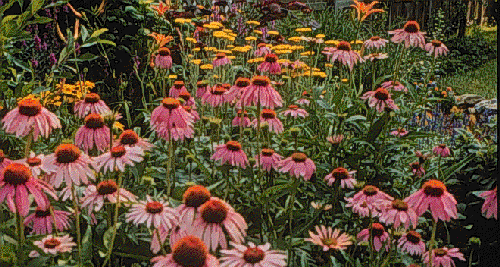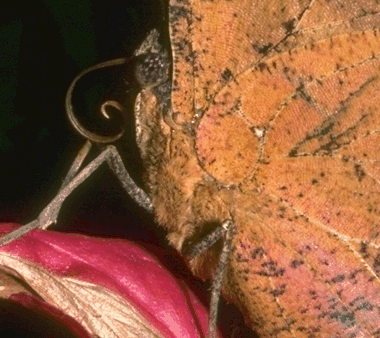How To Make Butterfly Gardens
ENTFACT-006: How To Make Butterfly Gardens | Download PDF
by Stephanie Bailey, Extension Specialist
University of Kentucky College of Agriculture

Nectar Preferences
Different species of butterflies have different preferences of nectar, in both colors and tastes. A wide variety of food plants will give the greatest diversity of visitors. Try staggering wild and cultivated plants, as well as blooming times of the day and year. Groups of the same plants will be easier for butterflies to see than singly planted flowers.
Some varieties of flowers which are easy to find and grow in Kentucky, and will be attractive to many species of butterflies include:

L-R: Aster, Black-Eyed Susan, Butterfly Weed, and Daylilies

L-R: Lilac, Coreopsis, Lavender, and Butterfly Bush

L-R: Goldenrod, Marigold, Oxeye Daisies, and Hibiscus

L-R: Purple Coneflower, Redbud, Rosemary, and Verbena
Other Attractants
Another way to attract adult butterflies to your yard is to offer places (food plants) for females to lay their eggs. Some females are pickier about which host to lay their eggs on than others. A few specific examples of butterflies and their host plants are listed at the end of this fact sheet.
The larvae can also be very noteworthy. Some caterpillars have hairs or forked spines, which may be or may not sting (often the hairs are just for show). It's better to be safe than sorry, so wear gloves when handling these larvae. Certain swallowtail caterpillars imitate snakes or bird droppings. Other caterpillars, like sulphers, are camouflaged, or blend into their surroundings very well. If caterpillars are eating excessive foliage from a prominent or desirable part of a plant, try moving them (with gloves on if they're hairy) to the backside or another less noticeable portion of the plant.
All insects are cold-blooded and cannot internally regulate their body temperature. Butterflies will readily bask in the sun when it is warm out, but few are seen on cloudy days. It is a good idea to leave open areas in a yard for butterflies to sun themselves, as well as partly shady areas like trees or shrubs, so they can hide when it's cloudy or cool off if it is very hot.
Butterflies also like puddles. Males of several species congregate at small rain pools, forming puddle clubs. Permanent puddles are very easy to make by burying a bucket to the rim, filling it with gravel or sand, and then pouring in liquids such as stale beer, sweet drinks or water. Overripe fruit, allowed to sit for a few days is a very attractive substance (to them!) as well.
Butterfly Anatomy
Adult butterflies and moths have mouth parts shaped into a long, coiled tube. Forcing blood into the tube straightens it out,allowing butterflies to feed on liquids. Butterflies get all their food from this tube, which limits them to nectar and standing water. Larvae, on the other hand, have chewing mouth parts which they use to skeletonize or totally defoliate leaves. Butterflies have large, rounded compound eyes which allows them to see in all directions without turning their head. Like most insects, butterflies are very nearsighted, and are more attracted to large stands of a particular flower than those planted singly. They do not see "red" as well as we do, but they can see polarized light (which tells the direction the sun is pointing) as well as ultraviolet light, which is present on many flowers and guides them to nectar sources. Butterflies also have a very well-developed sense of smell from their antennae. All butterflies' antennae are club-shaped, as opposed to moths, which can be many shapes but often are feathery.

Detail of Butterfly Mouthparts
Butterflies begin their life as an egg, laid either singly or in clusters depending on the species. A very tiny caterpillar emerges and, after consuming its egg shell, begins feeding on its host plant. Caterpillars must crawl out of their skin or molt, usually around five times, before changing into a pupa. Finally, an adult butterfly emerges, spreads its wings and flies away. This type of development is complete metamorphosis.
Butterfly gardens are a great source for your own enjoyment, photo opportunities, or an outlet for artistic talent. These gardens can also be extended to interest youth in nature, by providing a small window of native inhabitants of the local environment. On a final note, it's important to conserve butterflies when possible since their habitat is constantly diminishing due to the increasing needs and consequent development of roads and housing.
Additional Information
Tekulsky, M. The Butterfly Garden, Harvard Common Press, Boston, 1985. 144 pp. Xerces Society/Smithsonian Institution. Butterfly Gardening: Creating Summer Magic in Your Garden. Sierra Club Books, San Francisco and the National Wildlife Federation, Washington, D. C. 1990.
Butterfly Nectar Preferences and Larval Food Plants
- Larval food plant:snapdragon
- Nectar: aster, milkweed chickory, coreopsis
- Larval food plant: nettle, elm
- Nectar: rotting fruit & sap, butterfly bush, dandelion
- Larval food plant: citrus trees, prickly ash
- Nectar: lantana, Japanese honeysuckle, milkweed, lilac, goldenrod, azalea
- Larval food plant: violet
- Nectar: ironweed, milkweed, black-eyed susan, verbena
- Larval food plant: milkweed
- Nectar: milkweed, butterfly bush, goldenrod, thistle, ironweed, mints
- Larval food plant: willow, elm, poplar, aspen, birch, hackberry
- Nectar: rotting fuit & sap, butterfly bush, milkweed, shasta daisy
- Larval food plant: nettle
- Nectar: rotting fruit and sap, daisy, aster, goldenrod, butterfly bush,
- milkweed
- Larval food plant: cherry, ash, birch, tulip tree, lilac
- Nectar: butterfly bush, milkweed, Japanese honeysuckle, phlox, lilac, ironweed
- Larval food plant: willow, poplar, apple
- Nectar: rotting fruit, sap, aster, goldenrod, milkweed
Revised: 1/94
CAUTION! Pesticide recommendations in this publication are registered for use in Kentucky, USA ONLY! The use of some products may not be legal in your state or country. Please check with your local county agent or regulatory official before using any pesticide mentioned in this publication.
Of course, ALWAYS READ AND FOLLOW LABEL DIRECTIONS FOR SAFE USE OF ANY PESTICIDE!
Butterfly Images: University of Kentucky Entomology & Corel Photo CD
Flower images: Dr. M. Witt, University of Kentucky, Department of Horticulture
